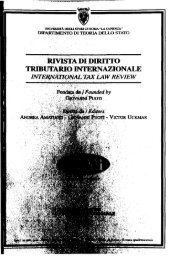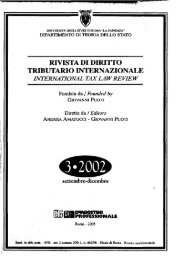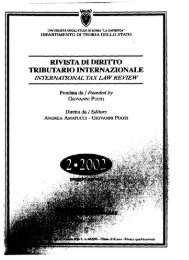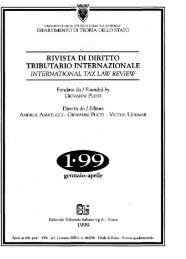RIVISTA DI DIRITTO TRIBUTARIO INTERNAZIONALE - Rdti.it
RIVISTA DI DIRITTO TRIBUTARIO INTERNAZIONALE - Rdti.it
RIVISTA DI DIRITTO TRIBUTARIO INTERNAZIONALE - Rdti.it
Create successful ePaper yourself
Turn your PDF publications into a flip-book with our unique Google optimized e-Paper software.
D. Gutmann: Tax treatment of pel1sions. A comparative anal:rsis<br />
the tax treatment become TEE. This is the case in Luxembourg, where employees<br />
subscribing to occupational schemes are taxed at a !lat rate of 25%<br />
in the contribution phase. This very originai mie can be explained by the specific<br />
s<strong>it</strong>uation of a country which hosts many foreign workers who do not<br />
necessarily intend to spend their old days there. The perspective of a tota! exemption<br />
of pension payment also serves as a tax incentive to establish in Luxembourg,<br />
since <strong>it</strong> leaves the overall taxation at a level of 25%. The Danish<br />
case is also to be noticed insofar as an g% labour market contribution is<br />
levied on the employee at the time of the contribution (5). The German case<br />
could also be mentioned here, because of the partial application of the TEE<br />
system, but some further details will be given later ono<br />
I! also happens that the EET Mode! will be set apart in favour of an<br />
ETT system. In Italy, for instance, employee's contributions to private<br />
pension funds are tax exempt (6) while the financial returns gained by<br />
private pension inst<strong>it</strong>utions are subject to a Il % tax. In Sweden, a 15%<br />
annual yie!d tax is also levi ed on Swedish residents who hold funds or reserves<br />
re!ated to pensions (7). In Sw<strong>it</strong>zerland, cap<strong>it</strong>ai gains made by second<br />
and third pillar funds on real estate are taxed.<br />
It may thus be observed that the EET system defin<strong>it</strong>ely adm<strong>it</strong>s important<br />
exceptions. Such a conclusion is not particularly originai if compared<br />
to the Commission's results. It is far more interesting, in retum, to<br />
observe that those countries which are said to comply w<strong>it</strong>h the EET Model<br />
often apply other models at the same time.<br />
2') S0111e coul7tries simultaneousl.\' appl." EET and o/her 1Il0deis<br />
As everyone knows, if tax law were simple, there would not be tax<br />
lawyers anymore (8) ... This is why \Ve should express our grat<strong>it</strong>ude to<br />
(5) Denmark also levies an annual cap<strong>it</strong>ai gain tax on the fund (15%). See N.<br />
Winther-Sorensen. "Taxation of Cross Border Pension Provision", paper presented at<br />
the EATLP Meeting of Lisbon, lune 2001, p. 2.<br />
(6) This exemption only applies \\-<strong>it</strong>hin a maximum amount of 12% of the empIoyee's<br />
incorne up 10 a lim<strong>it</strong> of about 5.100 ? (see F. Marchetti and E. Ruggiero, "Taxation of<br />
Pensions in Italy", paper presented at the EATLP Meeting of Lisl:xm, lune 2001, pp. 5-6).<br />
(7) This does not prevent the pension payment to be taxcd as \Veli, thus making<br />
the Swedish system an EIT one.<br />
(8) No \Vorry about this pcrspective: as H. J. Ault put <strong>it</strong>, "simplification is a complex<br />
problem" (see "Tax simplification from a Comparative Point of View", in lnterl1atiol1al<br />
Studies il1 Taxmioll: [alt' alld EC01lOmics, Liber Amicorum Leif Mutél1 , KJuwer<br />
Lav.: International, Scries on International Taxation, n° 21, 1999, p. 43).<br />
<strong>RIVISTA</strong> <strong>DI</strong> <strong>DI</strong>RIITO <strong>TRIBUTARIO</strong> I\TERNAZIO:"JALE 312ml






